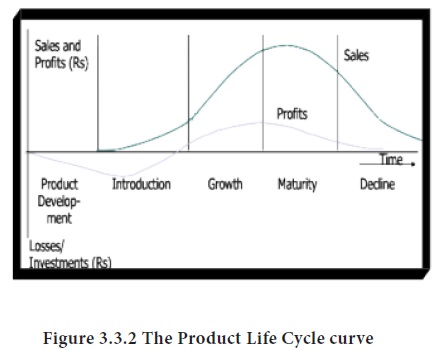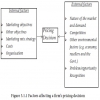Home | ARTS | Marketing Management
|
Pricing and Product Life Cycle - Pricing Policies and Constraints
MARKETING MANAGEMENT - Pricing Policies and Constraints
Pricing and Product Life Cycle - Pricing Policies and Constraints
Posted On :
From a strategic point of view, the product life cycle provides a framework for thinking about pricing decisions.
Pricing and Product Life Cycle
From a strategic point of view, the product life cycle provides a framework for thinking about pricing decisions. You may recall the discussion in Unit-2 about the product life cycle (Figure 3.3.2). Four phases may be identified in the product life cycle: introduction, growth, maturity and decline as shown in the figure below.

Each phase presents different opportunities and constraints on price.
During the introduction phase, pricing can be a quandary, especially if you enjoy a temporary monopoly. In that situation, there may be no direct competitor and thus no benchmark for what buyers will tolerate or for their sensitivity to price differences. There may be indirect competitors (substitutes), however, and they can be used as starting points for the pricing decision.
The total economic value equation becomes relevant, wherein the price of the best alternative is known but the value of the performance differential of the new product is unknown. Customers themselves may have difficulty in sizing up the value of something that is new and different. They too lack benchmarks of value. In such instances, any of the following strategies may be adopted:
1. Skimming: Some people will be happy to pay a high price for anything that is new and unique. This strategy, of course, is short term and contains dangers like attracting competition. IT companies offer their software products at high price as the life cycle for them is short. At the time of introduction, computers, mobile phones, washing machines, were high priced as the investment costs were high.
2. Penetration pricing: A low price may have the threefold benefits of (1) getting established as the market share champion, (2) discouraging market entry by competitors, and (3) creating broad-based demand for the product. This is more suitable to consumer convenience products which can be sold in large volumes.
3. Maruti –Udyog introduced Maruti -800 with the price tag of Rs.50,000 which subsequently was raised to Rs.1 lakh, as demand exceeded supply. Tatas are going launch the Nano car at Rs.1 lakh.
4. Cost-plus: In a monopoly, the producer can administer its own price and cost-plus is one way of determining that price. However, product monopolies are short-lived.
Pricing decisions in this introductory phase are not only difficult but also deadly important. Putting too high a price on a newly introduced product may kill it in its infancy, undoing the work of many employees over a long period of development.
The growth phase is characterized by increasing unit sales and accelerating customer interest. If competitors have not yet surfaced (which is an unlikely event), skimming may be appropriate. All the deep-pocketed buyers who simply had to be the first in their neighborhoods to own the product have already been skimmed in the introduction phase. So now, the price must be reduced gradually, skimming other market segments that are progressively more price sensitive.
A producer that enjoys prime position on the experience curve will also want to progressively reduce prices during this phase. Doing so will maintain its margins even as the strategy expands unit sales and punishes late-into-the-game rivals in the marketplace. Some of these rivals will either take a loss on every sale or simply wind up.
By the time a product enters this phase, growth in unit sales is leveling off and the remaining competitors are trying to find ways to differentiate their products. During this phase, one may see sellers offer different versions of the product, each version trying to colonize a targeted segment. Price is one of the factors used in this strategy (i.e. by developing and pricing good, better and best versions to expand the product line).
Competition gets ugly in this phase. Total demand for the product category is now visibly slipping, perhaps because of the appearance of superior substitutes or because of market saturation. Whatever the case, unit sales will continue to decline. Some companies will get out of the business entirely; those that remain will aggressively try to take business away from the rivals. Every player in the market is trying to harvest as much as possible from a contracting market. Price tactics include the following:
1. Beat a retreat on price, but work overtime to reduce production costs. Success in the latter will maintain a decent profit margin
2. Increase the price on the few remaining units in inventory. This is because there may be a small number of customers who still rely on that particular product. This is particularly true of replacement parts. Here the seller hopes that the higher price will compensate for fewer sales. When the inventory is exhausted, the product line is terminated.
Pricing is one of the linchpins of marketing strategy and success. How is the company making its pricing decisions? Are these decisions appropriate for the current phase of the product life cycle? The most reliable method of pricing is to get inside the heads of customers, because how they value the firm’s products relative to those of competitors and substitutes matters more than anything else.
From a strategic point of view, the product life cycle provides a framework for thinking about pricing decisions. You may recall the discussion in Unit-2 about the product life cycle (Figure 3.3.2). Four phases may be identified in the product life cycle: introduction, growth, maturity and decline as shown in the figure below.

Each phase presents different opportunities and constraints on price.
Introduction phase
During the introduction phase, pricing can be a quandary, especially if you enjoy a temporary monopoly. In that situation, there may be no direct competitor and thus no benchmark for what buyers will tolerate or for their sensitivity to price differences. There may be indirect competitors (substitutes), however, and they can be used as starting points for the pricing decision.
The total economic value equation becomes relevant, wherein the price of the best alternative is known but the value of the performance differential of the new product is unknown. Customers themselves may have difficulty in sizing up the value of something that is new and different. They too lack benchmarks of value. In such instances, any of the following strategies may be adopted:
1. Skimming: Some people will be happy to pay a high price for anything that is new and unique. This strategy, of course, is short term and contains dangers like attracting competition. IT companies offer their software products at high price as the life cycle for them is short. At the time of introduction, computers, mobile phones, washing machines, were high priced as the investment costs were high.
2. Penetration pricing: A low price may have the threefold benefits of (1) getting established as the market share champion, (2) discouraging market entry by competitors, and (3) creating broad-based demand for the product. This is more suitable to consumer convenience products which can be sold in large volumes.
3. Maruti –Udyog introduced Maruti -800 with the price tag of Rs.50,000 which subsequently was raised to Rs.1 lakh, as demand exceeded supply. Tatas are going launch the Nano car at Rs.1 lakh.
4. Cost-plus: In a monopoly, the producer can administer its own price and cost-plus is one way of determining that price. However, product monopolies are short-lived.
Pricing decisions in this introductory phase are not only difficult but also deadly important. Putting too high a price on a newly introduced product may kill it in its infancy, undoing the work of many employees over a long period of development.
Growth phase
The growth phase is characterized by increasing unit sales and accelerating customer interest. If competitors have not yet surfaced (which is an unlikely event), skimming may be appropriate. All the deep-pocketed buyers who simply had to be the first in their neighborhoods to own the product have already been skimmed in the introduction phase. So now, the price must be reduced gradually, skimming other market segments that are progressively more price sensitive.
A producer that enjoys prime position on the experience curve will also want to progressively reduce prices during this phase. Doing so will maintain its margins even as the strategy expands unit sales and punishes late-into-the-game rivals in the marketplace. Some of these rivals will either take a loss on every sale or simply wind up.
Mature phase
By the time a product enters this phase, growth in unit sales is leveling off and the remaining competitors are trying to find ways to differentiate their products. During this phase, one may see sellers offer different versions of the product, each version trying to colonize a targeted segment. Price is one of the factors used in this strategy (i.e. by developing and pricing good, better and best versions to expand the product line).
Decline phase
Competition gets ugly in this phase. Total demand for the product category is now visibly slipping, perhaps because of the appearance of superior substitutes or because of market saturation. Whatever the case, unit sales will continue to decline. Some companies will get out of the business entirely; those that remain will aggressively try to take business away from the rivals. Every player in the market is trying to harvest as much as possible from a contracting market. Price tactics include the following:
1. Beat a retreat on price, but work overtime to reduce production costs. Success in the latter will maintain a decent profit margin
2. Increase the price on the few remaining units in inventory. This is because there may be a small number of customers who still rely on that particular product. This is particularly true of replacement parts. Here the seller hopes that the higher price will compensate for fewer sales. When the inventory is exhausted, the product line is terminated.
Pricing is one of the linchpins of marketing strategy and success. How is the company making its pricing decisions? Are these decisions appropriate for the current phase of the product life cycle? The most reliable method of pricing is to get inside the heads of customers, because how they value the firm’s products relative to those of competitors and substitutes matters more than anything else.
Tags : MARKETING MANAGEMENT - Pricing Policies and Constraints
Last 30 days 575 views













